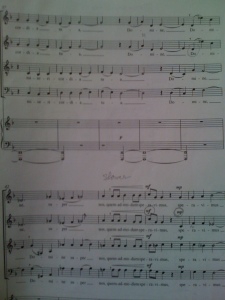It’s such a tough meme to kill. Why are people so committed to the proposition that intensive and comprehensive study (or even not so intensive and comprehensive study) somehow ruins one’s ability to appreciate a given phenomenon? I’m sure it’s in no small part a rationalization of laziness and/or lack of perceptive capabilities.
Those active in the scientific fields have done a pretty good job of quashing this meme in their own context. Students of biology, medicine, physics, etc are generally students of biology, medicine, physics, etc because they are excited to learn about the phenomena pursuant to those fields; they believe better understanding leads to greater appreciation. They don’t undertake their studies simply to observe phenomena and then not study them.
The situation in the arts is a curious one. This being Musical Beef, I’ll concentrate on musical art. Most professional musicians have gone to school to study music. Institutions devoted to the study of music are out there. It’s often expected that a candidate for a job in the musical field hold degrees in the relevant area of musical study. Yet the very same people who expect a professional musician to hold music degrees, and would even drag out their own degrees from prestigious conservatories in order to boast, are constantly prattling about how trying to explain music to others (or even to yourself) ruins the listening experience. Nonsense. What I think the author of the popular blog Proper Discord was trying to say was that there is a time and place for musical study, and actually during the concert is not it.
Don’t get me wrong. My first and best test for musical greatness remains the “goosebump test.” Concerning the uninitiated’s concert experiences, Proper Discord writes: “they enjoyed the good stuff, and didn’t enjoy the bad stuff.” I share the view that music can be appreciated without knowing much about it. Indeed, music’s effect on the limbic system (and more specifically the sympathetic nervous system – why we get goosebumps!) isn’t dependant on a full understanding of various compositional techniques. I just don’t think getting to know more about the music diminishes one’s appreciation of it.
Proper Discord closes with a quote from Georges Braque: “There is only one valuable thing in art: the thing you cannot explain.” Oh, boy. Postmodern deepity time. If you can’t explain it, how do you know it’s any good? Or completely awful? If someone comes to me proclaiming the greatness of this or that, I want them to be able to give me at least SOME kind of a rationale, just as I always feel obliged to explain why I think something is great. And you certainly shouldn’t pronounce negatively on something without being able to explain what the problems are. “Just because,” or “de gustibus non est disputandum” only gets us to the postmodern quagmire where, since everything is great, nothing winds up being great.
This, however, I couldn’t agree with more:
A lot of the time, though, we rationalise what we like after we’ve decided that we like it.
Unfortunately, I think this is how quite a lot of music finds its way into the canon.
PS: The video at the bottom of the article is not the first time Proper Discord has compared music with food. I don’t think the analogy is apt (although I have to admit that post is mostly pretty clever and funny). We’ve evolved to crave the once-rare fats and sugars now found in junk food. That’s why it’s so satisfying to indulge. Our inner-caveman is unaware that sensible portions of healthy food are in plentiful and immediately available supply. Is there a similarly self-preserving genetic directive compelling us to indulge in “cheesy pop music”? I don’t think so.

